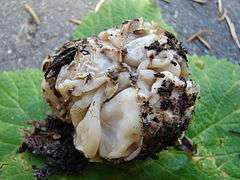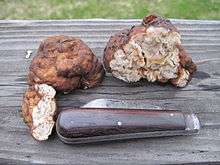Geopora cooperi
Geopora cooperi, commonly known as the pine truffle or the fuzzy truffle, is a species of fungus in the family Pyronemataceae. It has a fuzzy brown outer surface and an inner surface of whitish, convoluted folds of tissue. Widely distributed in the Northern Hemisphere, the species has been recorded from Asia, Europe, and North America.
| Geopora cooperi | |
|---|---|
 | |
| Scientific classification | |
| Kingdom: | |
| Division: | |
| Class: | |
| Order: | |
| Family: | |
| Genus: | |
| Species: | G. cooperi |
| Binomial name | |
| Geopora cooperi Harkn. (1885) | |
Taxonomy
First described by American mycologist Harvey Willson Harkness in 1885,[1] the fungus is named for the original collector, J.D. Cooper.[2] It is commonly known as the "pine truffle"[3] or the "fuzzy truffle".[4]
Description

The roughly spherical fruit bodies grow underground. Ranging from 2 to 8 cm (0.8 to 3.1 in) in diameter, they are yellow-brown to darker brown with a fuzzy, furrowed external surface.[2] The inside of the fruit body comprises deeply folded and convoluted tissue with some internal open spaces between them.[4] Young pine truffles ooze a whitish juice when they are cut.[2] The odor of the internal flesh is usually mild, but David Arora has noted the existence of a form in the Western United States that smells similar to fermented cider. Geopora cooperi fruit bodies are edible.[4]
The smooth, elliptical or roughly spherical spores measure 18–27 by 13–21 µm and have an oil droplet. The asci (spore-bearing cells) are typically eight-spored. They are arranged as a palisade of cells forming a hymenium that covers the inner surfaces of the internal folds.[4]
Habitat and distribution
Fruit bodies grow singly or in groups under the soil surface near conifers and Eucalyptus trees. In the field, they can sometimes be detected by the mound of soil they push up as they grow.[3] In western North America, it is found from Mexico to as far north as Alaska. Specimens from the latter location have been found under aspen and willow trees. Geopora cooperi is a snowbank mushroom, as it commonly occurs after snow has melted.[4] The fungus has also been recorded in China,[5] western Asia (Turkey),[6] Pakistan,[7] and Europe.[8] In Turkey, it is considered critically endangered.[9]
References
- Harkness HW. (1885). "Fungi of the pacific coast". Bulletin of the California Academy of Sciences. 1 (3): 159–77.
- Evenson VS. (1997). Mushrooms of Colorado and the Southern Rocky Mountains. Englewood, Colorado: Westcliffe Publishers. p. 45. ISBN 978-1565791923.
- McKnight VB, McKnight KH (1987). A Field Guide to Mushrooms: North America. Peterson Field Guides. Boston, Massachusetts: Houghton Mifflin. p. 55. ISBN 0-395-91090-0.
- Arora D. (1986). Mushrooms Demystified: a Comprehensive Guide to the Fleshy Fungi. Ten Speed Press. pp. 846–7. ISBN 0-89815-169-4.
- Son G. (1993). "Geopora cooperi f. Gilkeyae, a hypogeous fungus new to China". Acta Botanica Yunnanica (in Chinese). 15 (1): 105–6. ISSN 0253-2700.
- Solak MH, Gucin F, Isiloglu M, Pacioni G (2003). "A new record of Geopora cooperi f. cooperi from west Asia". Pakistan Journal of Botany. 35 (4): 473–5. ISSN 0556-3321.
- Ashraf T, Khalid AN (2012). "New records of Pezizales from Pakistan". Mycotaxon. 119: 301–6. doi:10.5248/119.301.
- Trappe JM, Trappe M, Evans FB (2007). Field Guide to North American Truffles: Hunting, Identifying, and Enjoying the World's Most Prized Fungi. Berkeley, California: Ten Speed Press. p. 44. ISBN 1-58008-862-7.
- Çinar H, Sermenli HB, Işiloğlu M (2014). "Some critically endangered species From Turkey" (PDF). Fungal Conservation (4): 26–28.